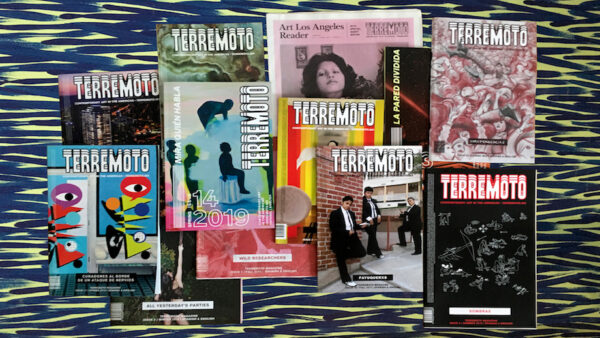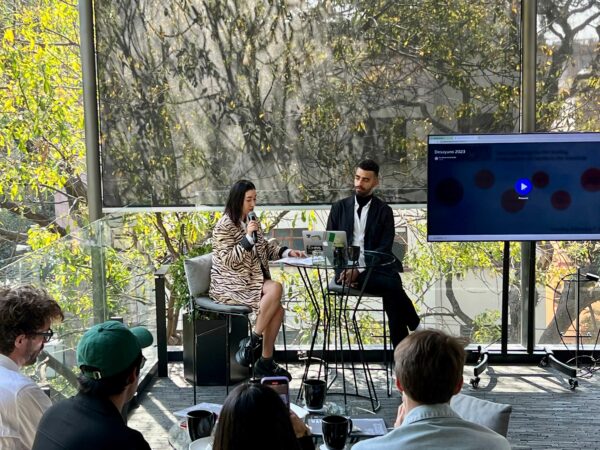In the midst of its 10th anniversary, the esteemed Latin American publication Terremoto kicked off Art Week Mexico City with a breakfast reception on the rooftop terrace of the Brick Hotel in the city’s hip Roma Norte neighborhood. But rather than a casual mixer, the Tuesday morning event served as an opportunity for Terremoto Executive Director Helena Lugo and Development Director Adrian de Banville to share some pivotal news about the organization’s future. After publishing 24 issues between 2013 and 2022, Terremoto will no longer function as a magazine, but rather “an interdisciplinary cultural platform” with a roving artist residency in the works.
Before getting down to brass tacks, de Banville introduced Los Angeles-based artist Gala Porras-Kim for a presentation about her exhibition Entre Lapsos de Historias, which opens Saturday, February 11 at Mexico City’s Museo Universitario Arte Contemporáneo (MUAC). After speaking about the origins of several featured works — which pose open-ended questions about the complex dynamics between museums, institutions, objects, and artists — Porras-Kim thanked Terremoto for its continued support of her endeavors.
“I wanted to reminisce on the beginning of thinking through these long-term research projects,” Porras-Kim said. “In the beginning, it’s just very important to find some support — especially because I live in LA and there were so many projects that I wanted to do in Mexico. And so I’m very grateful that in the beginning there was support from Terremoto. … And now that it’s changing … I wish it the best.”
Lugo, who recently took over directorship at the invitation of Terremoto founder Dorothée Dupuis, then began to shed light on what those changes entail.
“Terremoto has been a space for fundamental conversations — conversations [about topics] that for sure are trending now but weren’t 10 years ago: sexual dissidence, indigenous voices, trans-feminist struggles, de-colonial thinking, radical perspectives and dialogues from the margins,” Lugo began. “Terremoto has acted as a place to reflect on the power relations that govern our experiences. It is a vital and necessary project for our art ecosystem. However, it is also a constant effort of self-sustainability. … During the last month, the most fantastic team and myself have been thinking, dreaming and confabulating not only on how to keep this platform going, but how to keep it relevant, ambitious and exciting. … Terremoto is changing. We may no longer operate as a magazine that you all knew and cherished. But we are creating new programs, new formats, and new possibilities for artists.”
While this in-progress reinvention includes a recently established artist council, extended archives, a website overhaul, and plans for a podcast, the most noteworthy development is easily Terremoto’s forthcoming Nomadic Artistic Residencies.
“We believe residencies can become critical sites of production and thinking for artists,” Lugo continued. “This is going to be our very first year and we want to explore decentralized territories. Every edition will gather five artists in a certain specific territory [for] a month … We want to do fully funded programs. This is very important to us. So we guarantee that every artist has the opportunity to participate in these programs.”
The inaugural edition of the residency will take place in the Sonora Desert, with a specific focus on the otherworldly landscape of El Pinacate and Gran Desierto de Altar Biosphere Reserve.
In keeping with its geographic focus on decentralized territories, the residency is rooted in “analog missions” — which NASA sums up as “field tests in locations that have physical similarities to the extreme space environments.” Also rooted in collaborative research, the Sonora Desert edition will connect artists with scientists from the Mexican Space Agency, the Mars Archive, and related programs at Universidad Nacional Autónoma de México.
“We want the artists to come and explore this desert for a month,” Lugo explained, “in order for them to think of utopian strategies of world-making, think of nonhegemonic futuristic [possibilities], and reflect collectively on how are we to keep this world. Or how are we to look for another one?”
Lugo indicated that a budget is being allocated for artists to produce new work and that each residency cycle will culminate with an exhibition and a companion print publication.
Open to artists living and working in Latin America, Terremoto’s Nomadic Artistic Residencies will be organized via an open call, the first of which is expected to be announced in March or April.
Those wishing to support Terremoto through its new chapter can consider joining one of two membership circles or attending the nonprofit’s annual benefit auction, which is set for March 15 at Proyecto Público Prim in Mexico City.




